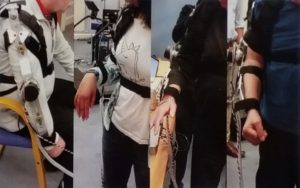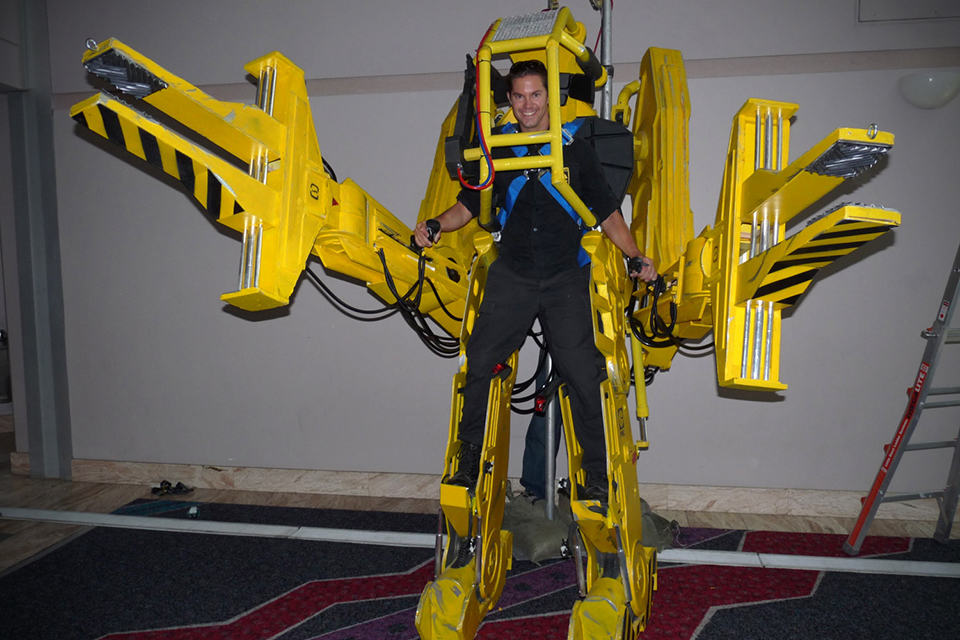exoskeletons
Exoskeletons leading the way
Dr Heba Lakhany from the University of Strathclyde talks to John Kersey about exoskeletons and how they can help overcome the effects of stroke.

What got you interested in technology in the first place?
Heba Lakhany (HL): “I am an engineer and I have a PhD in Artificial Intelligence from the University of Edinburgh. I work as a lecturer at the University of Strathclyde and lead a research group in Biomedical Engineering. My research focuses on developing cutting edge technologies to understand and assist human movement. These technologies are primarily to help people with mobility or movement impairment. I was always interested in technology and becoming an engineer meant that I have a serious chance in contributing to the development of technology.”
Tell us a little about your work with exoskeletons.

Four stroke survivors trialling an exoskeleton prototype.
(HL): “We are developing a robotic exoskeleton for rehabilitation and assistance of the upper limb for people with arm weakness or paralysis. The device is lightweight, wearable and portable. It could be used for rehabilitation at home. It allows for feedback to the user and the therapist about the performance of the user to adapt the therapy for better functional outcomes.”
What health & safety benefits and contribution do you see coming from exoskeletons?
(HL): “Exoskeletons are currently being used in industries such as automotive and manufacturing, where shifting and lifting is part of every day job. They are primarily are used as a protective gear to mitigate against repetitive strain injuries and lower back pain which leads to absences and shorten people’s working life. They are also being trialled in the construction industry.”
Earlier this year, SHP reported how Morrison Utility Services is trialling a number of exoskeletons out in the field, which are designed to reduce strain-related injuries.
How do you see them being further developed and brought into the workplace?
(HL): “As mentioned before, exoskeletons such as those produced by Ekso (active) and Laevo (passive) are already being trialled in workplace settings. These trials are showing excellent results. There is still some way to go for exoskeletons to be pervasive and to be used in every workplace setting, but the technology is certainly on the right track.”
Aside from exoskeletons, what future technology interests you?
(HL): “I also work and research brain computer interfaces (BCI). These are systems that detects intention from brain activity and then convert this into control signals. BCI has a number of applications notably as an assistive device for people with severe motor impairment such as high-level spinal cord injured survivors or people with late stage MS.
“Our aim is to keep people engaged, active and contributing to their communities for as long as they want by providing platforms for communications and interaction with their environment that may be unconventional but effective and easy to use.”
What do you see as the greatest challenge in your work so far?
(HL): “I believe the greatest challenge is to build and invent affordable technologies in exoskeletons and brain computer interfaces. Affordability is an important factor that will deem these technologies successful and usable.”
How do you see technology in general being applied to health & safety over the next five years?
(HL): “Technology will play an important role in health and safety. It is important that people in health & safety develop a vision to use and implement technologies in this field. Current and future technologies will be used to assist, extend and augment the capabilities of the workforce thus promising a safe and healthy workplace. This will both enable and empower the workforce which will in turn benefit employers, industries and businesses.”
[interaction id=”5dbc13207bf76b4c17bf795b”]
Exoskeletons leading the way
Dr Heba Lakhany from the University of Strathclyde talks to John Kersey about exoskeletons and how they can help overcome the effects of stroke.
John Kersey
SHP - Health and Safety News, Legislation, PPE, CPD and Resources
Related Topics
Drug and alcohol testing in a UK airport environment
Unleashing the power of emerging technologies in EHS
Passing the baton – Meet the 2024 IOSH President



I wonder how long before we have loaders like the ones in aliens
The Caterpillar P-5000 series power loader exists:
Seriously for that type of heavy duty application you would think an autonomous or driven robot would be a better solution?